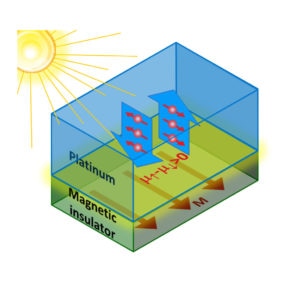Apr 27 2016
Isaac Asimov once stated that the most exciting phrase in science is “That’s funny…” and not “Eureka”. A “that’s funny” moment in a Colorado State University (CSU) physics lab has resulted in a fundamental discovery that is capable of playing a vital role in next-generation microelectronics.
 A schematic of the CSU team’s device that demonstrates using light to create a spin current. A spin voltage drives spin-up and spin-down electrons to move in opposite directions, resulting in a pure spin current across a platinum layer. (CREDIT: Colorado State University)
A schematic of the CSU team’s device that demonstrates using light to create a spin current. A spin voltage drives spin-up and spin-down electrons to move in opposite directions, resulting in a pure spin current across a platinum layer. (CREDIT: Colorado State University)
Nature Physics
Featuring in April 25 issue of Nature Physics, scientists headed by Mingzhong Wu, professor of physics in CSU’s College of Natural Sciences, are the first to illustrate the use of non-polarized light to develop a spin voltage, which is a unit of power produced from the quantum spinning of an individual electron. Monitoring electron spins for use in logic and memory applications is a fairly new field known as spin electronics, or spintronics. This new field played a significant role in the 2007 Nobel Prize in Physics.
Spintronics exploits the assumption of using electron spins to control, process and store details, with a fraction of the power required in standard electronics. Wu and his team focused on finding improved ways to monitor electron spins, the physics of which is yet to be completely understood.
Next-Gen Electronics
It is appropriate to consider the iPhone and other electronic devices built upon the accumulated scientific knowledge about charge current, which refers to negative and positive charges passing through a device. The constant issue here is the increased consumption of power by charge-current devices, and the electrical resistance leading to the loss of power in the form of heat. This is the reason why laptops constantly overheat.
Smaller, extremely powerful electronics are limited by these heat and power barriers. This is why science is now leaning on spintronics, because it provides a totally new method of making a device work. Charge current is not required to use power from an electron spin. All that is required is a magnetic material or a magnetic field, that has the potential to adjust the spins “up” or “down.” The up and down spins are considered as the analog to negative and positive charges.
The methods currently used to develop spin currents include using a heat source, microwaves, or a charge current, which can defeat the purpose to some extent. However, for the very first time the CSU used light, or photons as it is known in the quantum world, to produce their spin currents.
Similar things have been carried out by other scientists who used a particular kind of polarized light. Plain unpolarized light was used by the CSU scientists. Graduate student David Ellsworth, the first author on the paper, stated that the plain unpolarized light here is a halogen bulb purchased at Ace Hardware. A “pure” spin current without charge movement was illustrated by the scientists. This was an extraordinary achievement.
Curiosity Leads to Discovery
The scientists came up with the breakthrough while studying spin currents developed by the heat obtained from their Ace Hardware bulb. The “that’s funny” moment refers to the fact that the scientists observed data they were not able to explain.
Out of curiosity, the scientists analyzed all of the possibilities and decided that this seemingly light-induced spin current is capable of being a new quantum phenomenon. They examined it by designing novel control measurements involving varied magnetic insulators and metallic thin films, like platinum. The scientists replicated their findings in the lab, and then approached theoreticians from at Fudan University and the University of California Irvine to help them decipher the physics of what the scientists discovered. These experts became co-authors on the Nature Physics paper.
Wu stated that currently it is not possible to focus on real-world applications as this discovery is too new. Scientists are constantly making breakthroughs in theoretically understanding spin currents.
Just like with the photovoltaic effect when it was first discovered, no one thought at first of a solar cell. Technologies take time before they are used in real devices. This is a fundamental, new discovery.
Mingzhong Wu, Professor of Physics, College of Natural Sciences, CSU
Said Jake Roberts, chair of the CSU Department of Physics: “There have been tremendous technical advances in controlling light. What I see in this discovery is that now, they’ve linked light to spin control. Using a simple light source to produce a spin current offers new opportunities for power control and generation.”
Continuing the Inquiry
The researchers continue to explore the creation of spin currents by interchanging materials and using varied light sources. They illustrated light control in the infrared range, and proceeding into the visible or UV range would likely provide powerful applications for devices, according to Ellsworth.
The framework for generating and detecting spin currents is non-trivial. Meanwhile, there are hundreds of years of generating charge currents and knowing how to measure them and manipulate them and characterize them. Spintronics is a new field, and devices are just now coming onto the market that utilize some small part of this.
David Ellsworth, Graduate Student, CSU
The research was supported primarily by the U.S. Army Research Office, and was also supported by the Department of Energy and other funding agencies. The CSU team includes former graduate student Lei Lu, graduate student Houchen Chang and former postdoc Peng Li, as well as former undergraduate researcher Bryan Johnson and Poudre High School student Yuqi Bian, who joined Wu’s lab last summer through REAP (Research and Engineering Apprenticeship Program). Wu has mentored high school students through the REAP program since its inception in 2007.